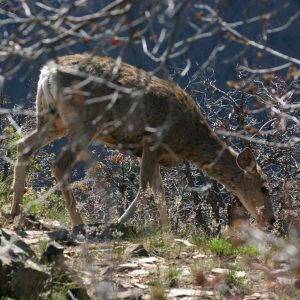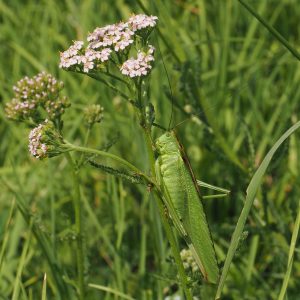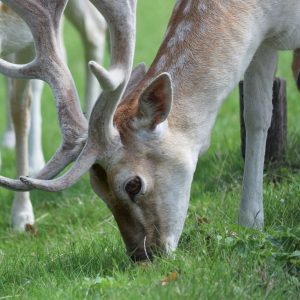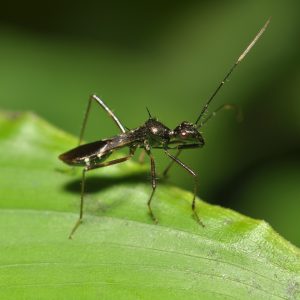Alright, fellow outdoorsmen, let’s chat about something that’s been bugging me (pun intended).
Ever been out in the woods, watching a white-tailed deer graze and thought, “I wonder if they eat bugs?”
I mean, we mostly see them munching on plants, leaves, and maybe a hickory nut or two.
But bugs? It might sound a bit out there, but nature’s always full of surprises.
This article is all about diving into that very question.
Do our deer friends have a taste for insects? And if so, why? So, grab your hunting hat, and let’s dig in.
Historical Perspective
Let’s take a step back in time. Did you know that the first species of deer roamed our planet about 30 million years ago?
Yep, that’s a long time before we set up our first hunting camps.
Now, these ancient deer weren’t just munching on plants.

There’s some chatter among experts that they might’ve been snacking on small animals, including eating insects. Imagine that!
A deer, back in the day, possibly chasing after a bug for a quick snack. It’s fascinating to think that our modern-day white-tailed deer might have inherited some of those old eating habits.
Deer’s Diet Composition
Now, if you’ve spent as much time in the woods as I have, you’ve probably seen deer nibbling on all sorts of green stuff.
What does a deer’s diet consist of? Plant material.
We’re talking leaves, twigs, buds, and even fruits and nuts. Yep, they love a good hickory nut (and bread) just as much as the next guy.
But here’s where it gets interesting. While primarily herbivores, they aren’t just sticking to plants.
Deer will eat bugs and insects as a part of their diet too.
When they’re munching on those woody plants or digging into the ground for roots, they’re bound to come across some creepy crawlies. And guess what? They don’t mind snacking on them either.
Now, the seasons play a big role in what’s on their plate. In the warmer months, it’s all about fresh greens and juicy bugs. But come winter, when food sources are scarce, they’ll munch on whatever they can find.
Types of Bugs Deer Eat
Ever wondered what kind of bugs deer will eat?

Bugs Deer Eat During Springtime
Spring is a lively time in the woods. The air is fresh, and everything’s waking up. Deer are no different. During this season, they have a taste for jumping critters like grasshoppers and crickets. Can you blame them? After a long winter, these bugs are like the chips of the forest – hard to resist!
Insects Deer Eat in Summer and Fall
As the days get warmer, deer change up their bug menu. They start eyeing those ticks (good riddance!), moths, and caterpillars. And let’s not forget other soft-bodied insects. These little guys are everywhere, and they’re packed with the good stuff – nutrients!
Deer Eat Bugs During Winter Too
Now, winter is a tough time for our deer buddies. Food is hard to come by. But nature has its ways. Even in the cold, deer find harder-bodied beetles, aphids, and scale insects to munch on. It’s like their version of a winter stew, keeping them going until spring rolls back around.
Reasons Why Deer Eat Bugs
Now, we’ve talked about the types of bugs deer munch on, but have you ever stopped to wonder why? I mean, with all that greenery around, why would a deer snack on a bug?
- Protein Power-Up First off, bugs are like the protein bars of the forest. Deer, especially those big bucks, need a lot of protein. You see those impressive antlers? They don’t just grow overnight. Antlers can shoot up quite fast during their peak growth times. And guess what fuels that growth? You got it, protein. And bugs, especially the likes of beetles and caterpillars, are packed with it.
- Vitamins and Minerals Now, it’s not just about the protein. Bugs are also little mineral treasure troves. They’re rich in stuff like phosphorus and calcium. These minerals are super important for deer. They need them for strong bones and those chompers they use to eat. Soft-bodied critters, like grubs, are especially loaded with these minerals.
- Energy Boost Every creature out there needs energy to go about their day, and deer are no different. Some bugs, like certain ants, are fatty little morsels. They give deer that energy kick, especially when winter’s around the corner and they need to stock up on calories.
Bugs and Deer’s Digestive System
Ever thought about what happens after a deer munches on a bug? Let’s dive into how these critters play a role in a deer’s tummy.
You see, plant stuff, especially the tough bits like cellulose, isn’t easy to break down.
Deer have a special system with gut flora – tiny little helpers living in their stomach. These micro-buddies work hard, breaking down the tough plant bits.

Now, here’s the cool part. Bugs are like a probiotic snack for deer. They’re packed with even more of these helpful bacteria.
When deer eat bugs, it’s like they’re adding more workers to their digestive team. These extra helpers make it easier for deer to get all the good stuff out of plants.
So, bugs aren’t just a tasty treat. They’re also a way for deer to keep their digestive system running smooth.
Nutritional Benefits of Bugs for Deer
We’ve seen deer munching on plants, but have you ever wondered about the goodies they get from those bugs deer eat? Let’s break it down.
Protein
First up, bugs are like little protein-packed snacks. Think of them as the trail mix of the forest.
Deer, especially those growing bucks, need protein to bulk up and grow those impressive antlers. Since deer don’t eat meat, guess what? Bugs like caterpillars and beetles are loaded with protein. It’s like nature’s own protein shake!
Minerals
Bugs aren’t just about protein. They’re also tiny treasure chests filled with essential minerals. Deer need things like calcium for strong bones and phosphorus for healthy teeth.
And where do they find them? They eat insects, of course! Grubs, in particular, are like a mineral buffet for our deer friends.
Vitamins
Now, let’s not forget about vitamins. Just like us, deer need their daily dose of vitamins to stay healthy.
And bugs, especially those juicy ones, come packed with essential vitamins that give deer that extra pep in their step.
Healthy Fats
Last but not least, some bugs are little fat bombs. And I mean that in a good way! Fats are essential for energy, especially when winter’s knocking on the door.

Bugs like certain ants are fatty delights, helping deer store up energy for the colder months.
So, next time you’re out in the woods and spot a deer nibbling on a bug, remember, it’s not just a random snack. It’s a carefully chosen treat, packed with all the good stuff deer need to thrive. Mother Nature sure knows how to set up a balanced diet, huh?
Wrapping Up
Well, folks, we’ve journeyed through the woods and unraveled quite the question “do deer eat bugs?”.
From munching on greenery to eating bugs, it’s clear that deer aren’t just simple grazers. They’re smart, making choices that give them the best mix of nutrients.
Whether it’s protein from beetles or minerals from grubs, deer eat what’s good for them.
So, the next time you’re out hunting or just enjoying the beauty of nature, and you spot a group of deer nibbling away, remember: there’s a whole lot of wisdom in their ways. Mother Nature sure did a fine job with these critters, didn’t she?
FAQs
Do all deer consume bugs?
Well, not every deer will be seen munching on bugs, but many do. It’s like how some of us prefer fishing while others are all about hunting.
Deer have their preferences too. But in general, depending on food availability, if a bug’s in their path and it’s tasty, they might just have a nibble.
Are there specific seasons when deer consume more bugs?
You bet! Summer’s the prime time. The woods are buzzing with bugs, and deer take advantage of this bug buffet. But they’ll also snack on insects in other seasons if they come across ’em.
Are there any potential health risks for deer consuming bugs?
Nature’s pretty smart. For the most part, bugs are a safe and nutritious snack for deer. But, just like anything, too much of a good thing can be bad. If a deer were to eat too many bugs and not enough plants, it might throw off their diet a bit. But Mother Nature usually keeps things in balance.